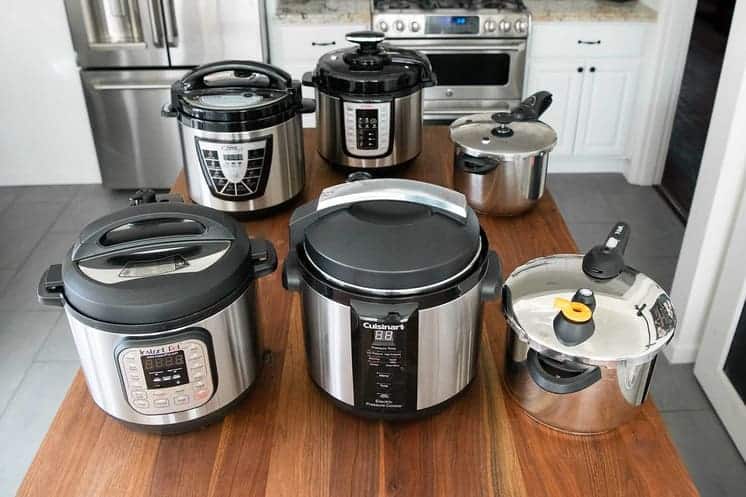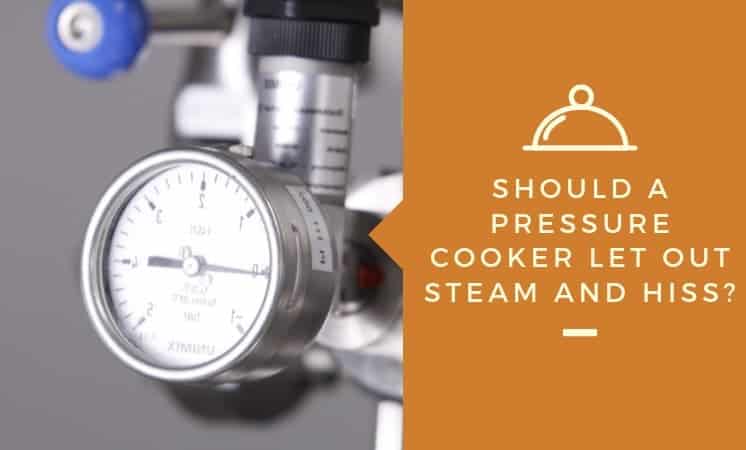While pressure cookers are now quite commonly found in thousands of kitchens across the country, mainly due to the fact that they save a lot of time and effort whilst cooking, they can be quite dangerous and misunderstood if one does not know how they work. A common question that pops up is whether or not your pressure cooker should be letting out steam? After all, the thought of it leaking or popping the lid is quite terrifying when you have boiling water at severe temperatures.
So, should pressure cookers let out steam during their cooking process? Yes. The lid on your pressure cooker is designed to maintain a safe level of pressure within the cooker and when the pressure builds too high, a safety valve will open to release the right amount of excess pressure. This is what results in the hissing sound you hear when steam is let out.
There’s a little bit more to why the pressure release is a necessary function though; read on to understand the reasons behind this safety mechanism.
So Why Do Pressure Cookers Release Steam Through Their Lids?
The reason why this question comes up a lot is that individuals most often associate the hissing noise with the sound of a tea kettle hitting its boiling point.
The idea here is that the water gets so hot within the tea kettle that it lifts the lid up, trying to be released, only to cause the whistling sound upon escaping. This noise signals to us that the water is ready to be used.
The pressure cooker works in a very similar manner but has one major difference; the food inside isn’t necessarily ready when your pressure cooker lets out steam unlike the tea kettle analogy above. In order to understand why pressure cookers release steam, first know how they work
A pressure cooker uses a form of liquid, such as water, stock, broth, or even wine, and traps the vapor that rises from the liquid in as steam.
How is the liquid trapped?
Your pressure cooker uses a seal between the lid and the bottom portion of the appliance. As more and more vapor rises, the pressure inside the cooker as well as the temperature of your liquid increases drastically. This increased temperature and pressure infuses the steam into the food, cooking your food in a fraction of the time that it would take using any other method.
If you are using water in your pressure cooker, the appliance will raise the boiling point of the water beyond the regular boiling point of 212 degrees Fahrenheit (100 degrees Celsius). This spike can reach anywhere between 212 degrees Fahrenheit and 250+ degrees Fahrenheit; which is why your pressure cooker may need to release some pressure every once in a while.
Should a Pressure Cooker Hiss & Why is My Pressure Cooker Hissing?
- The first reason is that you may not have sealed your pressure cooker closed properly or fully. Another reason for an improper seal is leaving the steam valve open accidentally. If the pressure cooker is not sealed, it cannot maintain the required pressure to ensure that your food cooks all the way through. You can denote whether or not your pressure cooker is sealed properly by checking the valve to ensure it is closed and checking around the lid to make sure there is nothing between it and the bottom half of the appliance.
- The second reason is that the pressure is too high inside the cooker. The only way you would know if the pressure is too high is if your cooker starts hissing at you. If this happens and your pressure cooker is properly sealed and the valve was closed upon the initiation of the cooking process, this is likely the reason behind the hissing. To reduce the pressure, you can either do one of two things.
If you are using a stove-top that utilizes fire to provide heat, reduce the heat. This will have an immediate effect on the pressure cooker.
If you have an electric stove-top, understand that it will take some time to reduce the temperature as heat from these elements takes time to cool down. If you are finding that this is happening a lot, use two heating elements instead of one when using your pressure cooker. Use one to help build up the pressure in the cooker and use the second on a simmer to reduce the temperature if needed.
As a side note: always turn the element on and pre-heat before the pressure cooker reaches its limit, as this will ensure that you have a swift and immediate effect on the pressure cooker when you transfer it from one element to the second element.
Why Won’t My Pressure Cooker Build Pressure?

If you find that your pressure cooker will not maintain pressure for very long or at all, there could be an issue with your gasket. To troubleshoot this issue, take a look at the gasket and see if there is any noticeable damage to it.
If it has food residue along with it, remove it and wash it in cold water. Reinstall it and see if that is the issue. If it has cracks in it, you will need to replace it.
Do Electric Pressure Cookers Hiss or Make Noise?
If you have an electric pressure cooker, it should be virtually silent during the cooking process. The only time that an electric pressure cooker would ever make noise is at the end of the cooking cycle when the pressure is released.
Electric pressure cookers will not hiss, rattle, or whistle because the heat and pressure are maintained at stable levels by a computer chip. When your pressure cooker gets to the end of the cooking cycle, a programmed release response will let out the pressure, but the sound should not be very loud at all.
The only other noise that may come from your electric pressure cooker is if it has a built-in alert system to let you know when your food is ready. Otherwise, enjoy the silence!
Why Is My Pressure Cooker Foaming?!
Another common problem that individuals come across when cooking with particular food types is foaming, bubbling, and spraying issues. This generally occurs because you have overfilled the maximum capacity of the pressure cooker.
These appliances come with at least two maximum capacities, one which is high and one which is low. When cooking foods that expand, such as beans (which double their size), rice, and pasta, you only want to fill the pressure cooker to half, while all other types of foods can be filled up to two-thirds.
Here is why.
- Any type of rice or grain is likely to generate a significant amount of swelling, bubbles, and foam, which is likely to spray out of your pressure release valve.
- You are using the wrong opening method. When cooking foamy foods, you want to open the cooker using a natural release (not the valve).
- You added salt to your food. Even a small pinch of salt is enough to increase the foamy starch exponentially.
There are several solutions to this problem. You can either cook your rice, beans, and grains with vegetables and soup to counteract the expansion and foamy starch response or adhere to the guidelines set by the manufacturer of your pressure cooker and never fill above half way.
Other than this, make sure that you are using the natural release method instead of the pressure cooker valve.
To use the natural release method, leave the pressure release switch/valve in the sealed position when your cooking time ends and let the pressure release slowly on its own. Once the pressure has been fully released, the float valve will drop down and your pressure cooker will unlock and be openable.
A natural release will generally take anywhere between five and thirty minutes if you are using an electric pressure cooker. Use this method when cooking with foods that cause foam like pasta, grains, and rice as well as with large cuts of meat.

